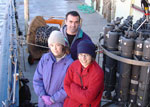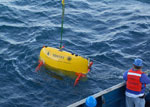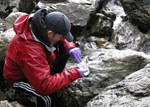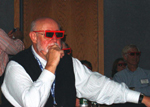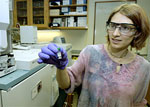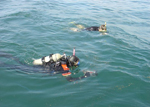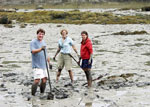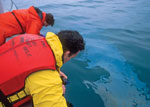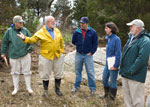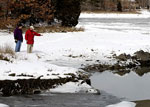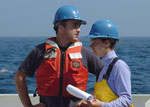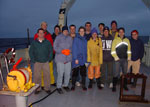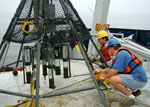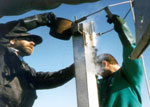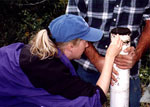Photo Galleries
Advances in Coastal Organic BioGeochemistry Symposium to honor John Farrington (November 2005)
To celebrate the career of John Farrington, a one-day symposium was held at Woods Hole Oceanographic Institution on Nov 8, 2005. Speakers from as far as Japan and Alaska attended and presented talks on a wide range of topics.
Isolating organic compounds from blubber
As part of a project to determine the sources of halogenated organic compounds in marine mammals, we started in 2003 to isolate several suspected compounds from 5 to 10 kg of blubber for radiocarbon analysis. Because of the large amounts of blubber involved in this work, much of the laboratory work had to be scaled-up from routine methods. This work is supported by the National Science Foundation (OCE-0550486)
Santa Barbara (CA) oil seeps
The Santa Barbara oil seeps release thousands of liters of gas and oil naturally each day and are only a few km away from the UC Santa Barbara (UCSB) campus. In collaboration with Professor Dave Valentine (UCSB) and his student, George Wardlaw, we are studying the geochemical fate of the seeped oil with comprehensive two-dimensional gas chromatography (GCxGC).
Lowes Cove, ME
In collaboration with Professor Gary King (UMaine), we have been studying the acorn worm, Saccoglossus bromophenolosus, and its natural product, 2,4-dibromophenol. Lowes Cove, which is quite close to the UMaine Darling Marine Center (Damariscotta, ME), is an ideal location to study these worms.
Bouchard 120 oil spill (April 2003)
In April 2003, the oil barge Bouchard 120 spilled 400,000 liters of No. 6 fuel oil into Buzzards Bay, MA. Initially, we collected oil samples floating on the water surface in Buzzards Bay. We then settled on a six-month survey studying how the composition of oil changed on oil-covered rocks at Nyes Neck (N. Falmouth), which is located on the east side of Buzzards Bay.
Winsor Cove (Bouchard 65 oil spill 1974)
In October 1974, the oil barge Bouchard 65 spilled an unknown amount of diesel fuel in Buzzards Bay near the entrance to the Cape Cod Canal. This site has been studied by George Hampson since it occurred. To investigate the long-term fate of the spilled oil, we began to study it in 2002 and compare the results to our work at Wild Harbor Marsh.
Wild Harbor Marsh (Florida oil spill 1969)
In September 1969, the oil barge Florida spilled 700,000 liters of diesel fuel in Buzzards Bay near West Falmouth, MA. This site is one of the most well-studied oil spills in history due to the excellent work of Max Blumer, John Teal and his graduate student Kathy Burns, Howard Sanders and his colleague George Hampson, and John Farrington. To investigate the long-term fate of the spilled oil, we began an intensive study in 2000. Colleagues include Rick Gaines and Glenn Frysinger of the US Coast Guard Academy and Ivan Valiela and Jen Culbertson of Boston University.
R/V Cape Hatteras cruise (Summer 2004)
As part of joint project to understand the sources and cycling of black carbon in the Gulf of Maine, scientists mainly from Phil Gschwend (MIT) and Chris Reddy's (WHOI) research groups collected water and sediment in the Gulf of Maine during a seven-day cruise aboard the R/V Cape Hatteras in September/August 2004.
R/V Oceanus cruise (April 2004)
As part of joint project to understand the sources and cycling of black carbon in the Gulf of Maine, scientists mainly from Phil Gschwend (MIT) and Chris Reddy's (WHOI) research groups collected water and sediment in the Gulf of Maine during a seven-day cruise aboard the R/V Oceanus in April 2004.
R/V New Horizon cruise (Spring 2001)
During a two-week long cruise in May/June 2001, a scientific crew of mainly WHOI scientists collected sediment and water samples along the west coast of the United States. The cruise started in Redwood City in San Franscisco Bay, headed north to the Columbia River and then due south ending in San Diego. Tim Eglinton of WHOI was the chief scientist.
Pettaquamscutt River, RI (April 1999)
In april 1999, we drove ~100 km to the Pettaquamscutt River, RI and collected a series of sediment cores. The goal of this effort was to build a historical record of combustion-derived molecules over the past two centuries. Please note that these samples were collected with a freeze corer.
Siskiwit Lake, Isle Royale National Park, Lake Superior (Summer 1998)
In the summer of 1998, we went to Isle Royale National Park located in Lake Superior and collected a series of sediment cores. The goal of this effort was to build a historical record of combustion-derived molecules over the past century. This was a logistically and physically challenging field operation. For more details, refer to https://www2.whoi.edu/site/seafloorsampleslab/
